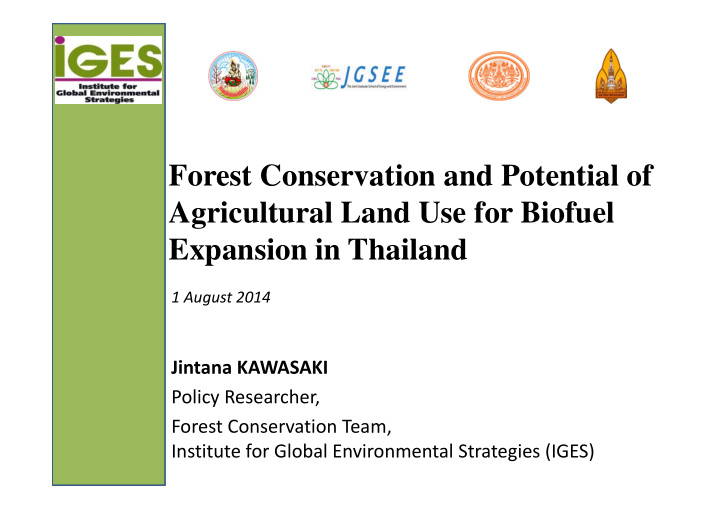



Forest Conservation and Potential of Agricultural Land Use for Biofuel Expansion in Thailand 1 August 2014 Jintana KAWASAKI Policy Researcher, Forest Conservation Team, Institute for Global Environmental Strategies (IGES)
The objectives of the research • To develop and apply a comprehensive evaluation methodology to assess land suitability for production of bioenergy feedstock, considering the national renewable energy policy, climate change, and socio ‐ economic factors. • To contribute to land use planning for bioenergy feedstock and agricultural food crop production and forest conservation
Proposed Methodology • Estimating life cycle GHG emissions of alternative good agricultural practices for sugarcane and cassava in current and near future • Assessment of crop yield under climate and physical conditions by using DSSAT model in current and near future • Assessment of land use changes associated with biofuel production, national renewable energy policy, climate change and socio ‐ economic factors, and suitable land use for the biofuel production by applying GIS over the last 15 year, current, and near future
Proposed Methodology (continue) • Assessment of role of forest communities in forest conservation and management
Thailand's forest areas (1973 ‐ 2013), Source: RFD, 2014a 250,000.00 200,000.00 Areas in sq. km 150,000.00 100,000.00 50,000.00 0.00 1973 1976 1978 1982 1985 1988 1989 1991 1993 1995 1998 2000 2004 2005 2006 2008 2013 Year Areas in sq. km
Direct causes of deforestation from the number of lawsuits in the RFD database Year # of lawsuit reported/recorded on the RFD database Encroachment Illegal logging Hunting/NTFP Total harvesting 2009 2,577 3,000 102 5,679 2010 2,857 3,318 97 6,211 2011 3,155 4,520 32 7,707 2012 2,745 3,939 51 6,735 2013 2,801 4,029 57 6,887
Study sites surrounding the Phu Wiang National Park in Khon Kaen Province
Risk of forest areas in the Phu Wiang National Parks was observed. Illegally cut down Thailand Rosewood ( Dalbergia cochinchinensis Pierre ) was found in the study sites.
I. Lifecycle GHG emissions calculation of sugarcane and cassava under alternative good agricultural practices Forest land – Sugarcane/Cassava 1. Identification of the potential LUC Paddy field – Sugarcane/Cassava scenarios for sugarcane and cassava Cropland – Sugarcane/Cassava Set ‐ aside land – Sugarcane/Cassava plantations at the study sites Degraded land – Sugarcane/Cassava Base case 2. Identification of base case and Green cane harvesting /Burnt cane harvesting alternative agricultural practices at Nutrient management the study sites Tillage/residue management 3. Life cycle inventory (LCI) data LCI per ton of biofuel crops production LCI per ha of land use collection for LC ‐ GHG calculations GHG emissions per ton crops (kg CO 2 eq/ton 4. LC ‐ GHG emissions analysis crops) for various alternative agricultural practices Recommendations on the sustainable 5. Interpretation agricultural practices/measures for mitigation of GHG emissions
II. Assessment of crop yields by using DSSAT model The Decision Support System for Agrotechnology Transfer (DSSAT) Version is a software application program that comprises crop simulation models for over 28 crops (as of Version 4.5) To assess the impact of climate change on crop yields: Rice, Cassava , Sugarcane
Methodology used for assessment 1. Data Collection and Create database • Weather data (daily data) • Soil data (Soil series) • Management • Land use (rice, cassava, sugarcane) • Genetic coefficient (rice, cassava, sugarcane) 2. Create Simulation mapping unit (SMU) by GIS technique 3. Crop yield simulation 4. *Evaluation • Simulating the effects of climate change on crop production • Crop yield assessment under alternative crop management scenario simulation.
III. Assessment of land use changes associated with biofuel production, national renewable energy policy, climate change and socio ‐ economic factors, and suitable land use for the biofuel production by applying GIS • To asses forest land reduction and land use change over the last 15 years in Khon Kaen Province • To identify the suitable land use for biofuel feedstock production and risk of forest area associated with increasing of biofuel feedstocks in current and near future (year 2021/22)
Equipment Topography Land use map Soil map Moisture regimes GPS Ortho photo Satellite
IV. Assessment of role of forest communities in forest conservation and management • To analyze changes of community agricultural land and forest land associated with biofuel expansions, economic and social factors, national renewable policy and national forest management planning • To study role of communities and activities in forest management Study sites in Khon Kaen Province Communities live in the land abutting on a protected forest area surrounding the Phu Wiang National Park Main crops mostly found in the study sites are rice, sugarcane and cassava
Thank you very much
Recommend
More recommend